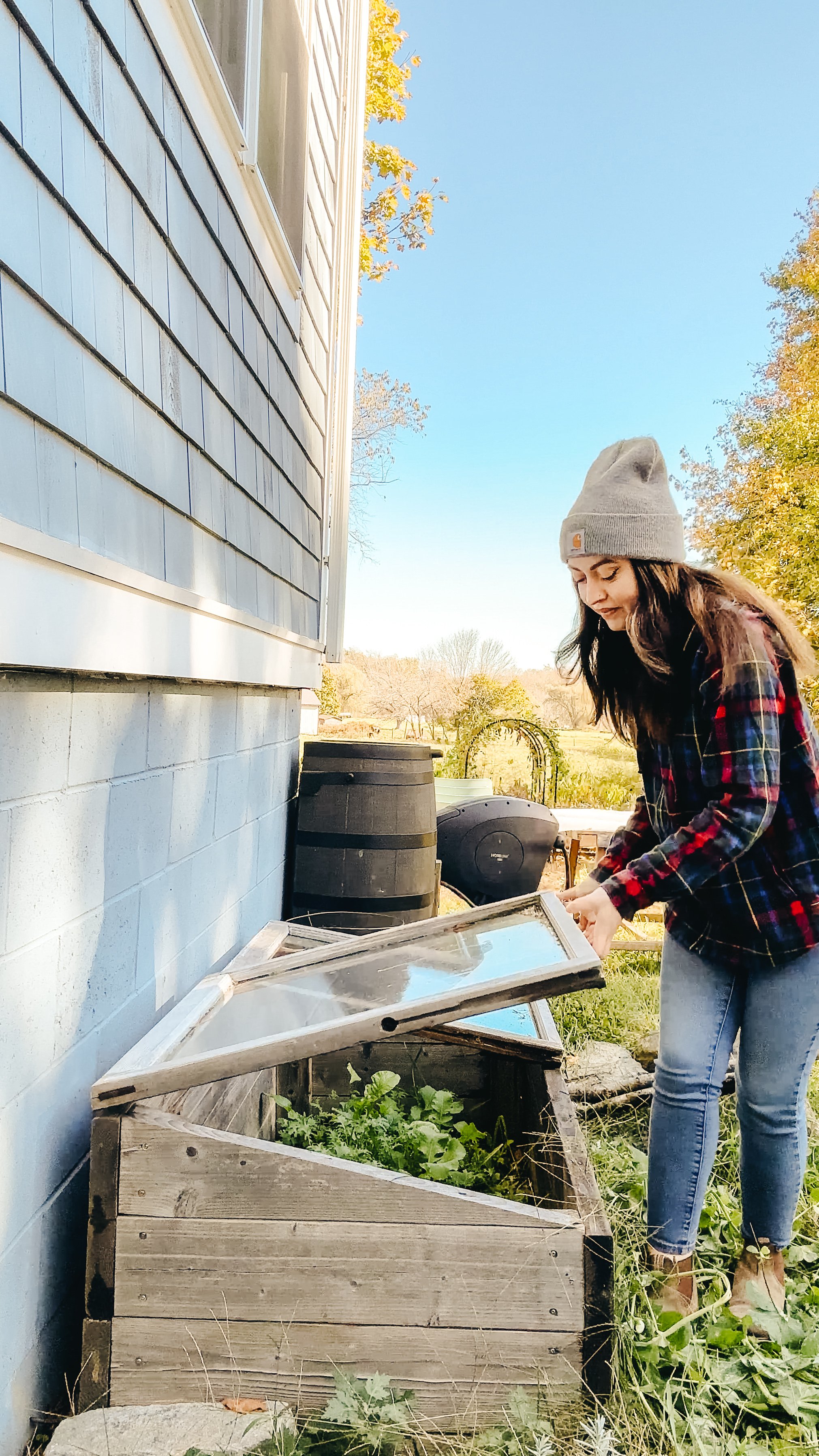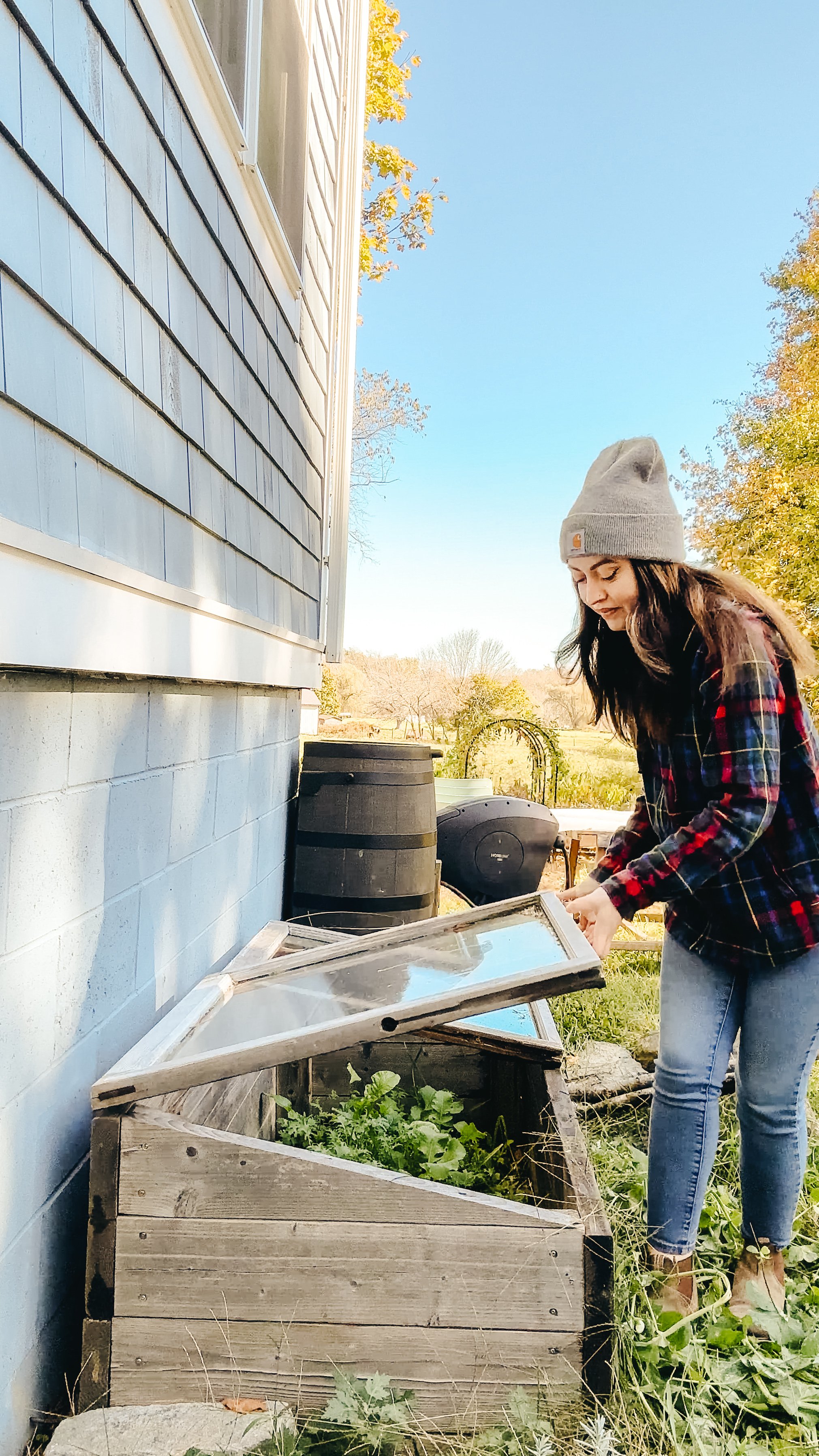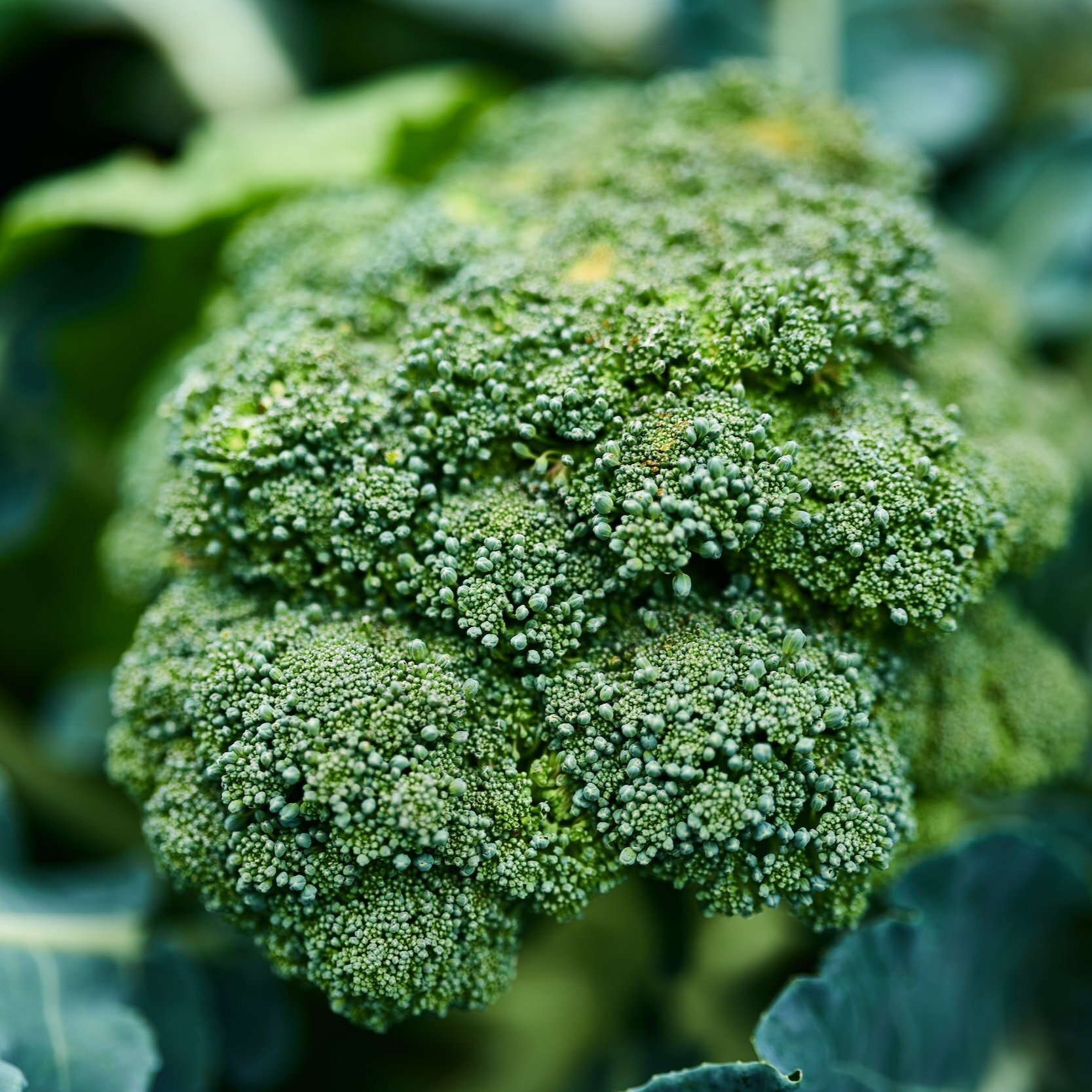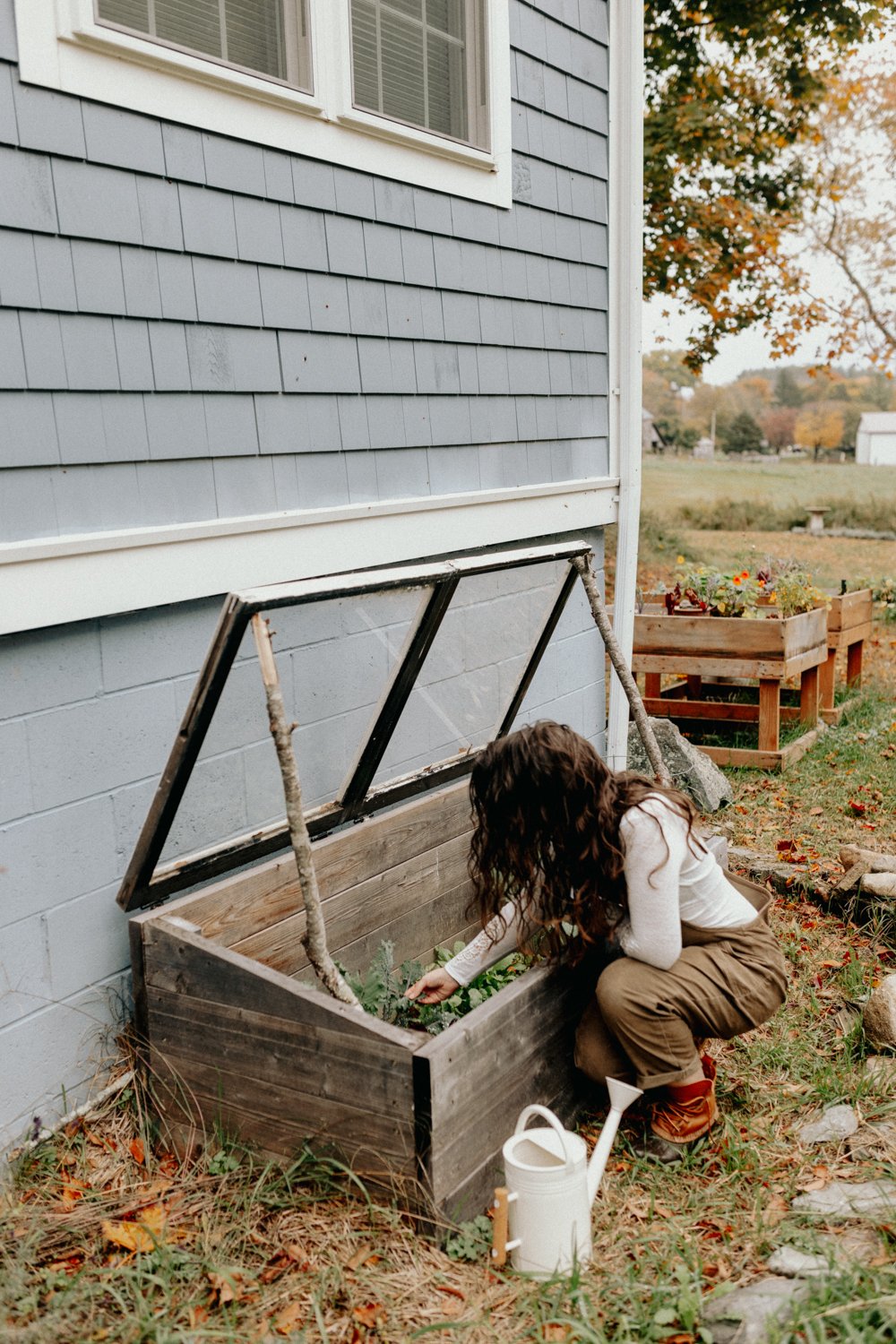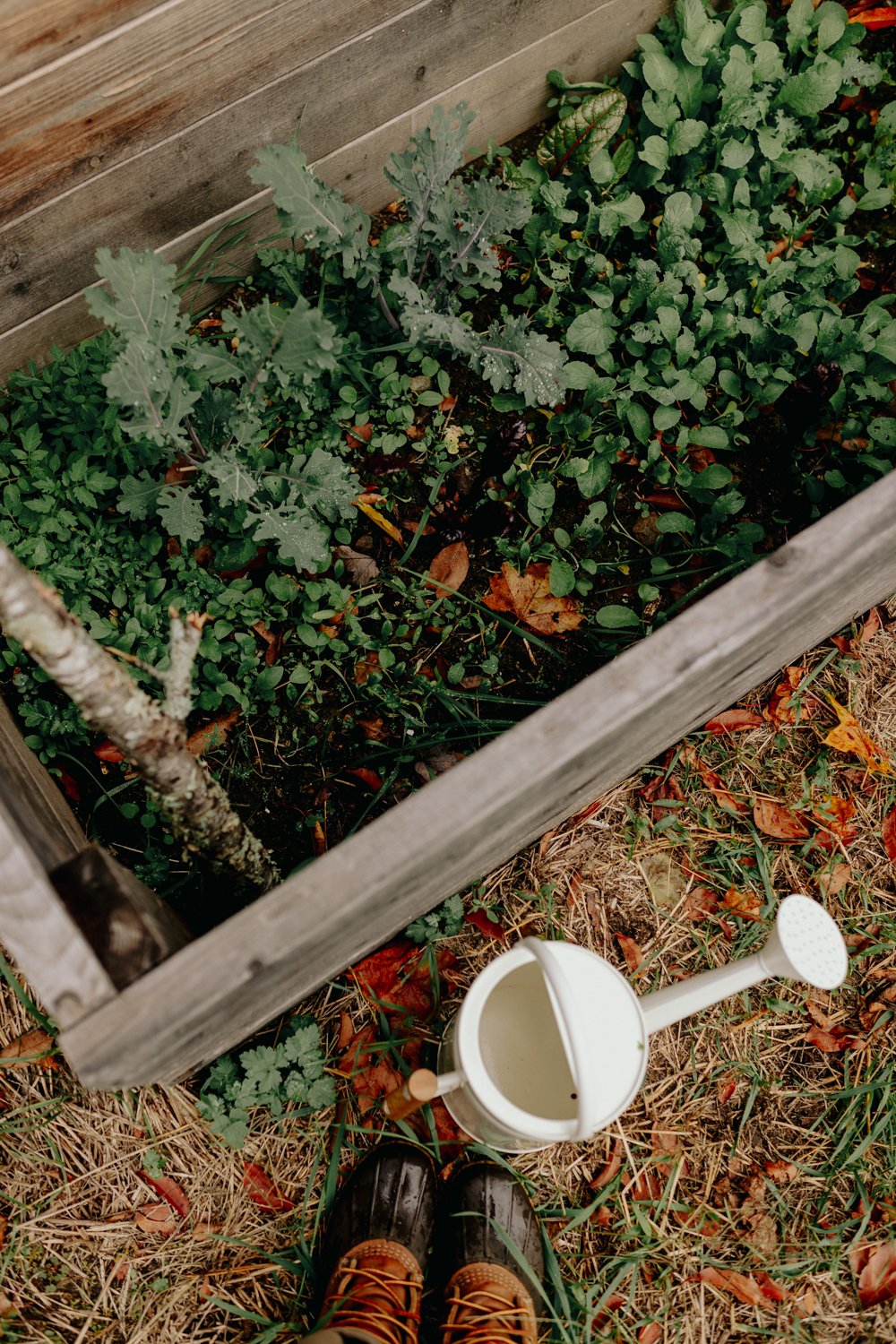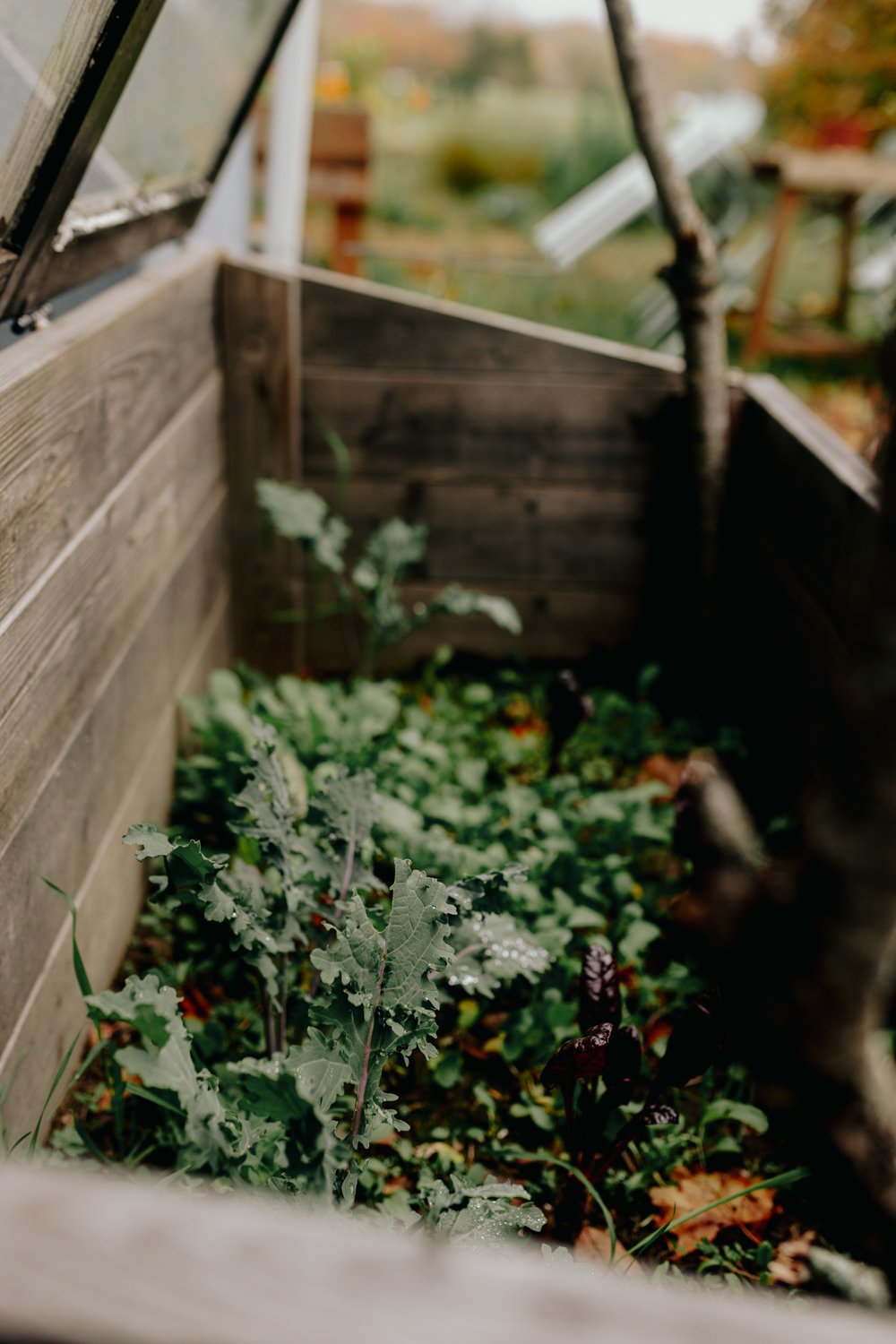BACKYARD GARDENING MADE SIMPLE
Extend Your Garden Season With These Techniques
With your garden prepped for winter, you may be ready to turn in and take a break from growing for a few months. But if you’re like me and the idea of the garden totally ending breaks your heart, there’s a few different ways we can extend our growing season and keep harvesting fresh food from the garden all year round. I’ll be using all of these methods in my own garden to grow cold loving crops while the snow falls.
With your garden prepped for winter, you may be ready to turn in and take a break from growing for a few months. But if you’re like me and the idea of the garden totally ending breaks your heart, there’s a few different ways we can extend our growing season and keep harvesting fresh food from the garden all year round. I’ll be using all of these methods in my own garden to grow cold loving crops while the snow falls.
How To Use Row Cover
There’s a good chance you have some plants already in the ground that can withstand cooler temperatures and give you harvests well into winter with a little planning. Plants in the brassica family for example have the ability to produce a type of natural anti-freeze that converts into sugars and makes the plants taste even better after a frost. But you can extend their life even further by utilizing frost covers which act as a cozy winter blanket and keep out the wind chill and moisture that causes the most damage to these cold hardy plants. These covers act as a shield against harsh frost, preserving the warmth around the plants and preventing frost damage. It's a simple yet effective measure to safeguard your garden and extend your harvest.
Benefits of Mulch
We aren’t the only ones who benefit from an extra blanket or two in the winter months. A layer of mulch such as wood chips, pine needles or straw around perennial plants acts as insulation, protecting their roots from extreme temperatures. It also helps retain moisture and suppresses weeds, contributing to the overall well-being of your garden beds during the winter months. A good rule of thumb is to use four to six inches of mulch around the plants - just don’t press the mulch up against the plant itself. We are insulating the roots, not the aboveground parts.
Using cold frames/cloches
A cold frame works by creating something like a mini-greenhouse, trapping warm air through solarization inside of the box and insulating the plants within from the worst that winter has to offer. We control the temperature inside of the cold frame with a simple vent - the hinged lid can be propped open with different sized sticks to allow excess heat to escape on warmer days, but for the most part in our deep New England winters the lid stays firmly shut until we trudge through the knee deep snow to harvest.
If you have the time and physical ability, building a cold frame yourself is absolutely the most economical solution. Purchasing one ready-made can cost you anywhere from $60-$500 and quality issues on the low end of that budget will prevent you from getting many years of use out of it. Meanwhile, if you build one yourself it can be done for far less than the low end of that range, and produce an end result that will be sturdy enough to continue providing shelter to your winter crop for years to come. While old windows can be fragile and prone to breaking, when they can be found for free I still find it a better option than a new piece of corrugated plexiglass.
DIY CATTLE PANEL Hoop House
Hoop houses are used by growers in all types of climates for many different reasons - but the main goal is climate control, whether that is to make the growing area colder using the artificial shade created or warmer by taking advantage of the insulating properties of the covered area to effectively move your grow zone south.
If you’ve never seen a hoop house before, you probably have and just didn’t realize it! The basic idea is that you form some sort of rounded roof structure using metal rods, cattle panel or pvc that bends down and is anchored to the ground and cover that with heavy duty greenhouse plastic that lets light in but keeps wind out and provides some insulation.
You can build your own greenhouse easily in an afternoon with just the help of one other person, and you don’t need any special skills or carpentry experience either. The hardest part is honestly just getting the cattle panel - they are huge, so unless you have a truck you’ll probably need to rent something or have them delivered. Click here for my full guide to build your own DIY cattle panel hoop house.
Cold Tolerant Plants
Of course, with any of these methods you still won’t create tropical conditions for your plants if you live in a colder climate. So it’s important to stick with plants that are known to tolerate temperatures down to about thirty degrees fahrenheit. Here’s a list of everything I’ll be growing this winter:
Gai Choy Mustard
This mustard matures in 40-60 days and grows anywhere from six to ten inches wide and ten to twelve inches tall. This is a head forming traditional Chinese mustard with a mild flavor when it’s young.
Bloomsdale Spinach
This is a dependable, open pollinated variety that matures in 28-45 days and grows about six to eight inches tall with dark green, thick and curly leaves. It’s a prolific grower with tender leaves and rich flavor.
Common Sorrel
This green has been popular in France and England for centuries but for some reason it isn’t as popular in the states. It matures in 60 days with bright green crinkled leaves that have a lemony spinach flavor.
Easter Egg Radish
This blend has red, white, pink purple and bi colored radishes that mature in just 30 days. Easter egg is a mild and crisp radish that forms small one inch globe shaped roots, so if you don’t like the spiciness of other radishes you may want to try this one.
French breakfast radish
These radishes are super mild - almost sweet and mature in 28 days. The root is scarlet with a white tip about 1 inch around and 2 or 3 inches long.
Spanish black radish
This is an extra large medium spicy radish that matures in 60-70 days with a black exterior and white interior. The globes are about 3-4 inches in diameter when mature. Since this is a winter radish it needs shortening day length and cool temps to mature, so this one gets planted later than the other radish varieties I’m growing.
Bok Choy Choko
I can’t live without this for my stir fries and this variety is so good and tender when harvested when it’s only about four inches tall. It matures in around 50 days and has smooth, leafy blades in a cluster with crisp, pale green stems. Choko was bred to be small and heat tolerant.
Big Seeded Mache
Mache can survive temperatures down to ten degrees fahrenheit and matures in 60 days. It’ll grow to be about six inches tall and eight inches in diameter with dark green, spoon shaped soft leaves in a loose rosette.
Tokyo Long White Bunching Scallion
These Japanese scallions are long, slender, mild and mature in 65 days. They are sweet enough to use in pretty much anything from salads, soups, and stir-fry dishes and grow about 16-18 inches tall.
Olesh Tres Fine Endive
This is a mildly bitter flavored green with a really interesting frilly texture that matures in 42-70 days. It grows about six inches wide and tall in rosettes with broad crinkled green leaves.
Ruby Red Swiss Chard
Chard can withstand moderate freezes and matures in 50-60 days, growing about 24 inches tall and eighteen inches wide with dark green crinkled leaves, red veins and stalks. I use this the same way I use spinach
Danvers Carrot
This variety was actually created an hour from where I live way back in the day when growers were looking for a carrot with improved yield, color and uniformity. It matures in about 65 days. It’s a sweet classic carrot that’s resistant to cracks and splits and roots grow about six inches long/
Astro Arugula
I said I would never grow this, but there’s very few foods I actively dislike and I have a personal rule that I re-try foods I hate about once a year in different forms or varieties and since arugula is so cold hardy, I had to bite the bullet with this and try a new type to see if I can learn to love it. Astro matures in 32-55 days and supposedly has more of a mild flavor than other varieties when the plants are young so I’m hopeful.
Mizuna Mustard
This tender Japanese mustard is milder than other varieties and ready to harvest in 30-50 days. It can grow up to a foot tall and wide but it’s usually harvested when it’s smaller.
Rosette Tatsoi
This beautiful leafy green is more flavorful than traditional bok choy and matures in 45 days. It is super cold tolerant down to 15 degrees fahrenheit and can be harvested even in the snow. It grows pretty low and wide with spoon shaped dark green thick leaves in a rosette.
Tendergreen Mustard
This is also called mustard spinach, but it’s not actually mustard OR spinach. It’s super easy to grow, hardy and productive and matures fast in 30 days to be about two feet tall and up to two feet wide with smooth dark green glossy leaves.
Are you team take a break for the winter, or keep growing?
Fall Gardening 101: How to Plant a Thriving Vegetable Garden for the Cooler Months
Fall gardening is more limited, since not as many plants thrive in the colder weather of September, October or November. But the plants that are resilient enough to survive these colder temps are that much more gratifying to harvest. In this blog post, you’ll learn everything you need to know to plant a fall garden and keep your garden going as long as possible.
No one in a state that experiences all four seasons wants to think about fall and winter in the summer, but sometimes it pays to look ahead. If you’re wondering if it’s too late in the year to start a garden, or you’re noticing some gaps starting to form as your spring plantings reach the end of their harvestable life span, fall gardening is the answer. Gardening in zone 6, we don’t get to grow all year long unless we have cold frames, a green house or a hoop house - our season for a productive garden is from about May to October, and even within that limited season we have to contend with variable temperatures at the beginning and end of that time period. A fall garden is our final push to maximize the yield we can get in this limited time frame, as well as a second chance for beginner gardeners new to gardening to join in and get planting their first garden with easy to grow crops to start saving money and eating healthier.
Fall gardening is more limited, since not as many plants thrive in the colder weather of September, October or November. But the plants that are resilient enough to survive these colder temps are that much more gratifying to harvest. In this blog post, you’ll learn everything you need to know to plant a fall garden and keep your garden going as long as possible.
Types of vegetables that can be grown in the fall
Certain groups of vegetables thrive in the cooler temperatures of fall, and many even require that cooler weather in order to germinate properly. Some can survive temps as low as 20F degrees. Coincidentally, many of these are great options for beginners to grow if you’re just starting out. Fall vegetables are fast growing, since they need to reach maturity in a short amount of time before the cold of winter sets in fully, so you’ll be reaping the rewards of your garden quickly. They are usually pretty low maintenance too, so if you’re a beginner fall is the perfect time to start gardening.
Where to buy vegetable seeds
Botanical Interests is the only place I order vegetable seeds online. The quality is unmatched, they offer a wide variety of seeds and their customer service is excellent. I did about fifty percent transplants from the nursery in the garden this year and fifty percent direct sowed to avoid dealing with a seed starting setup this spring, and everything that I direct sowed in my garden this year came from Botanical Interests, and I had zero issues with germination. It doesn’t hurt that the seed packet illustrations are pretty enough to frame either. Of course, you can also get all the flowers and summer crops you’ll want for your garden too.
Here’s my top recommendations for planting your fall vegetable garden with picks and descriptions from Botanical Interests
Leafy greens
Many leafy greens germinate best in cooler temperatures. Wait to plant these until the heat of summer has fully passed for a quick harvest and you’ll be enjoying salads well into October (or add a DIY cold frame to your garden for fresh greens all winter long)
LETTUCE
From the Botanical Interests website:
Butterhead, also called Boston or Bibb, has soft, smooth leaves perfect for carb-free wraps.
Crisphead is your familiar iceberg, which perfectly complements a BLT sandwich.
Mesclun, literally means mixture, creating a diversity of texture and color. Mesclun is harvested when young, and perfect for a multitude of culinary dishes.
Leaf lettuce is soft, with a crisp rib and can be not only green, but red or red-tipped.
Romaine lettuce is upright with broad, stiff ribs—the classic ingredient in a crisp Caesar salad.
Summer Crisp, also called Batavia, forms a loose head with green or red leaves that are sweet and crisp.
SPINACH
'Bloomsdale' is an early 1800's, dependable, open-pollinated variety. For growing tender, baby greens in as little as 28 days, you can sow seeds just 1" apart. Very nutritious—lots of vitamins A and C and iron. Grows great in a container too!
SWISS CHARD
'Celebration' is a multi-colored chard that produces uniform plants with dark green, glossy leaves. Vibrant multi-colored petioles (stems) are various shades of pink, yellow, white, and orange.
Root vegetables
Root vegetables are sweetest and juiciest when harvested in cool weather. They usually prefer warmer temperatures to germinate, so you’ll want to get your seeds planted in August for a fall harvest. They tend to store for a long time in cold storage too, and certain crops like carrots can even be left in the frozen ground over the winter and harvested in the following year in early spring - the freeze makes them even sweeter!
CARROTS
Grown and eaten in Asia and Europe 1,000 years ago, these colorful carrots are available once again. Just like the popular orange carrots, red, purple, white, and yellow carrots contain plenty of vitamin A and other healthful nutrients. Carnival Blend carrots can also be harvested when only 3"-4" long for gourmet baby carrots.
RADISHES
'Round Black Spanish', also known as 'Noir Gros Rond d'Hiver', grown in the U.S. since the 1800s, is an extra large, winter radish that adds spiciness to raw or cooked dishes; spiciness declines when cooked. Winter radishes require a shortening day length and cool temperatures to mature the edible root; sow after mid-summer and into early fall. They can be stored for long periods.
'French Breakfast' has endured in gardens for over 100 years because of its wonderful, delicate flavor. This spring radish grows best during the cool periods of spring and fall but will also withstand some summer heat!
TURNIPS
Pure white and mild, 'Market Express' is a great baby turnip in salads, crudité trays, and pickling, as well as traditional cooked turnip dishes. The roots have a smooth texture and slightly sweet, fruity flavor that upgrades homegrown meals, and the greens are also delicious. Fast growing, enjoy 2" baby-sized turnips in only 30 days, or grow them to full size (4"–5") in just 40 days.
The globe-shaped roots of ‘Purple Top White Globe Turnips’ have purple shoulders above ground and are creamy-white below the soil level.
BEETS
Aside from the health benefits, which include significant amounts of fiber, potassium, folic acid, and vitamin C, beets come in many colors. 'Gourmet Blend' includes 'Detroit Dark Red' with deep red roots and delicious dark green tops, 'Chioggia' with interior rings of bright pink and white, and 'Golden' with bright yellow flesh.
Brassicas
Plants in the brassica family produce a form of antifreeze when exposed to cold temperatures that actually causes the plants to taste sweeter. I enjoy winter kale far more than summer kale - not to mention, there’s no cabbage moth pests in the winter chewing through every leaf before I have a chance to harvest it.
KALE:
'Red Russian', brought to North America in 1885, is sweet and tender all the time, making it excellent for mesclun, garnishes, and sautéing. The red veins, wavy margins, and foliage that resembles oak leaves make 'Red Russian' as attractive as it is delicious. Harvest baby greens in just 21 days.
BRUSSELS SPROUTS
‘Long Island Improved’ produce 1"–1½", blue-green orbs that look like tiny cabbage heads, and grow tightly and densely against the main trunk of the plant. The cluster of leaves at the top of the plant give it a palm-tree-like look. Long Island Improved was developed in the 1890s, quickly becoming the garden standard, and continues to be a dependable heirloom for home gardeners.
CAULIFLOWER
‘Snowball Y’ provides flavorful, 6" snow-white heads in just 70 to 80 days. The leaves naturally curl nicely around the heads providing self-blanching and protection from sun scald. Mature heads hold well in the garden, so they don't all have to be picked at once.
BROCCOLI
'Waltham 29' grows prolific side shoots and is specially adapted for cold tolerance. Freezes well. The 4"-6", blue-green heads are delicious raw or cooked.
Sprouting broccolis, like 'Burgundy', create one moderate to small main head, but the real show starts as it begins to produce generous side shoots. Purple broccolis are known for being quite tender, flavorful, and full of antioxidants, but in most cases also a bit fickle, needing cool temperatures–not 'Burgundy'; it's tolerant of a wider range of temperatures, which means a longer harvest period. Some gardeners pinch the first main floret off as soon as it is visible to encourage more abundant side shoots.
Garden Tip
Make sure to prepare your soil by top dressing your beds with fertilizer before you add new plants to your garden, as the soil is likely depleted from all the growth of the past few months. Pest pressure should be a lot lighter in your fall garden, and you won’t need to water as often since there won’t be as much heat drying out the soil. Fall gardening is an easy and fun way to extend your growing season, I hope you’ll give it a try!
Grow Food Outdoors All Year Long With Cold Frame Gardening
Living with arthritis as a gardener, I have formed a close bond with the land in order to better support my body. My immune system requires careful tending, and I find myself craving dark leafy greens, hearty soups and protein rich comfort foods as the weather turns cold. But in a cruel twist of fate, when my body craves these deeply nutritious foods most, the bitter cold of our New England winters do not accommodate a growing season which would allow me to cultivate all of the produce I wish to grow deep in December.
So how do we ask the land to sustain us through its deep hibernation? The answer may be found in the form of a simple wooden box called a cold frame.
As cold and snowy weather descends upon us here in the Northeast, I find my achy joints actively calling out for more attention. Living with arthritis as a gardener, I have formed a close bond with the land in order to better support my body. My immune system requires careful tending, and I find myself craving dark leafy greens, hearty soups and protein rich comfort foods as the weather turns cold. But in a cruel twist of fate, when my body craves these deeply nutritious foods most, the bitter cold of our New England winters do not accommodate a growing season which would allow me to cultivate all of the produce I wish to grow deep in December.
So how do we ask the land to sustain us through its deep hibernation? The answer may be found in the form of a simple wooden box called a cold frame.
This rustic frame set into the earth, snuggled up against the sunny south wall of our home provides us ample opportunities to tend, grow and gather even in the darkest days of winter. It can feel like pure magic to enjoy a diverse variety of produce even as we are cozy in our blankets beside the fire.
How does a cold frame work?
A cold frame works by creating something like a mini-greenhouse, trapping warm air through solarization inside of the box and insulating the plants within from the worst that winter has to offer. We control the temperature inside of the cold frame with a simple vent - the hinged lid can be propped open with different sized sticks to allow excess heat to escape on warmer days, but for the most part in our deep New England winters the lid stays firmly shut until we trudge through the knee deep snow to harvest.
Like many things in life, we cannot expect to circumvent nature entirely for our own benefit. Nothing in nature blooms all year. Try to plant delicate heat loving peppers, for example, and you will be met with disappointment. Similarly, the plants enjoy a slower season in winter, much the way we humans do. If you’re not convinced, I’d ask you to consider this: if the trees can take a break, so can you.
A cold frame is a lesson in slowing down and radically accepting things as they are. Your kale, radishes and lettuce will grow and thrive at a slower pace than you can expect in warmer seasons. The harvests are fewer, but more rewarding for the mere fact that they exist at all. And while a cold frame requires a certain amount of upkeep and planning in the beginning, this slowed down nature means that watering and weeding becomes virtually unnecessary in the coldest months.
Now, if you live in a climate that does not experience a cold winter season you may think a cold frame is unnecessary. Although, they continue to be useful even into the spring season here in New England since they make the perfect protected nursery in which to harden off your summer seedlings each spring. And if you can easily build one for cheap or free using reclaimed materials, why not give it a try?
Where should you put a cold frame?
You’ll want to choose a location for your cold frame that is protected from north winds and generally sunny. This means the best spot for your cold frame will have no shade from any trees, and preferably be placed with the back wall of the cold frame up against the south side of your house, shed or barn. If you don’t have a spot like this available, then anywhere without shade will do. You’ll just need to spend some extra effort properly insulating your box from the winds.
Speaking of howling winds, so long as it is protected from those north winds we discussed you shouldn’t worry yourself too much about creating something airtight. Your cold frame is not a greenhouse, and so we don’t expect it to function quite the same. Build your frame to be thick and sturdy, but don’t worry about every little seam and crack.
How to build a cold frame
If you have the time and physical ability, building a cold frame yourself is absolutely the most economical solution. Purchasing one ready-made can cost you anywhere from $60-$500 and quality issues on the low end of that budget will prevent you from getting many years of use out of it. Meanwhile, if you build one yourself it can be done for far less than the low end of that range and produce an end result that will be sturdy enough to continue providing shelter to your winter crop for years to come. While old windows can be fragile and prone to breaking, when they can be found for free I still find it a better option than a new piece of corrugated plexiglass.
We built our cold frame just as the first leaves began dusting the earth, making their final descent from the branches above. Pulling out the old wooden windows and reclaimed lumber from our basement, I didn’t really have a plan. This is the nature of projects on our little homestead - in order to put to rest my fears and limiting beliefs, I have a tendency to turn a blind eye to the specifics and figure things out as I go. “I’m just going to build a big rectangle, the size of the two windows combined, and stick the windows on top” I confidently told myself. It’s safe to say I don’t have a ton of confidence when it comes to building things, but I was betting that between the two of us, we could figure it out. A chill wind traveled across the field. I adjusted my hat over my cold ears and set to work.
This method of trial and error has generally served me quite well on this journey, and I’ve found it to be essential to growing plants in particular. A fussy Nasturtium in Georgia, for example, is going to have very different needs that one planted in Vermont. So why overwhelm ourselves with tips and tricks from every gardener in the land when we could simply plant, observe, expect failure and experiment until things go right?
You can use many different materials to build a cold frame - but the very best materials are the ones you already have. Our little pile of scrap lumber provided nearly everything we needed to create a sloped box on which to mount our hinges and old wooden windows.
The result was…lopsided. For some reason, the box wasn’t sitting level on the earth, the wood having twisted under tension at some point, unnoticed by our novice eyes. The old windows we used for a lid were chipping questionably safe paint flakes every time we opened and closed the hinges. But it was finished, and it was free, and so - in the ground it went. I packed straw around the exterior to fill in the gaps where the frame didn’t meet the soil and added extra in the space between the wall and the cold frame, set my plants in the earth and held my breath that I would discover an abundance of fresh food beneath the glass in a couple of months.
I suppose I shouldn’t have led with such an obvious spoiler, but the cold frame did work, and an abundance we did have, regardless of our lack of building skills. And so as its lessons compounded the cold frame became something more than a simple box to grow in. The weathered wood shines like a beacon, a reminder to ourselves that we can accomplish more than we think, and done is better than perfect.
What Can you grow in a cold frame?
Kale
Swiss Chard
Spinach
Radishes
Lettuce
Beets
Carrots
Arugula
Kohlrabi
Scallions
Parsley
Mustard
Best cold frames to buy
Don’t want to build your own cold frame? There are many pre-made options available that are built to last. I suggest looking for a cold frame that has a rot-resistant cedar base and shatterproof polycarbonate lid. If you already have raised beds, then a plant protection tent may be the best option for you as you can simply convert your raised beds into a cold frame for the winter months and then remove the tent structure in the summer heat. Here’s my recommendations for the best pre-made cold frames and tent frames you can buy:
The 3-Season Garden Protection Tent from Gardener’s Supply makes it easy to access plants within your raised bed and includes two covers and durable powder-coated steel frame. This tent provides 70% light transmission, 40" of head room at the peak, and has roll-up end windows for ventilation. A second cover protects against ravenous summer bugs and scorching sun. Three zippered doors on each cover provide easy access for tending and harvesting. Tie-downs secure the covers to the steel frame. Click to Shop
The Cedar Cold Frame from Gardener’s Supply is an attractive cold frame with a narrow footprint. The base is made from rot-resistant lumber with aluminum corners. The top is made with polycarbonate panels that diffuse light so plants don't "cook," and there are adjustable braces to hold panels at various intervals for ventilation. Click to Shop

